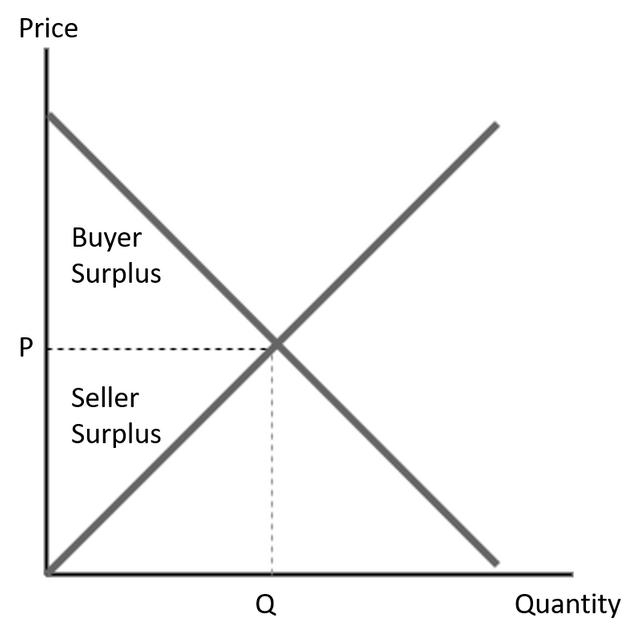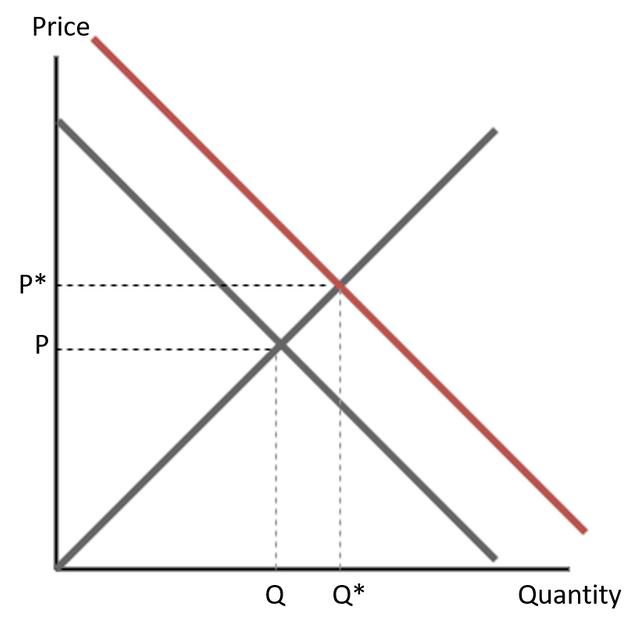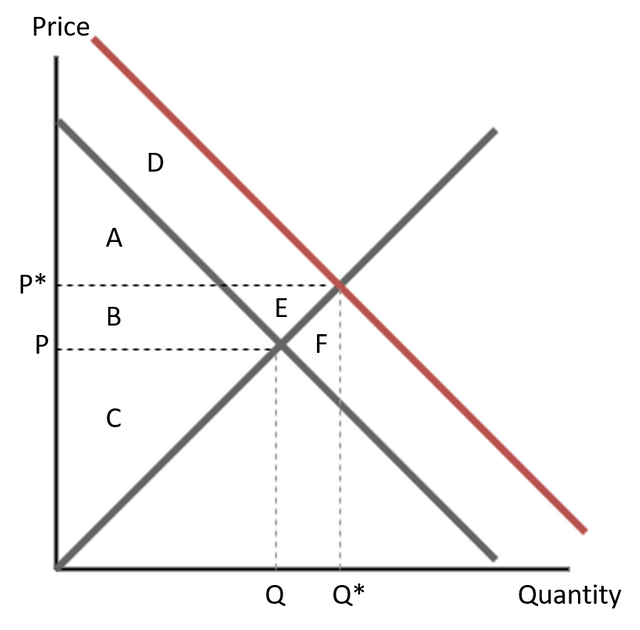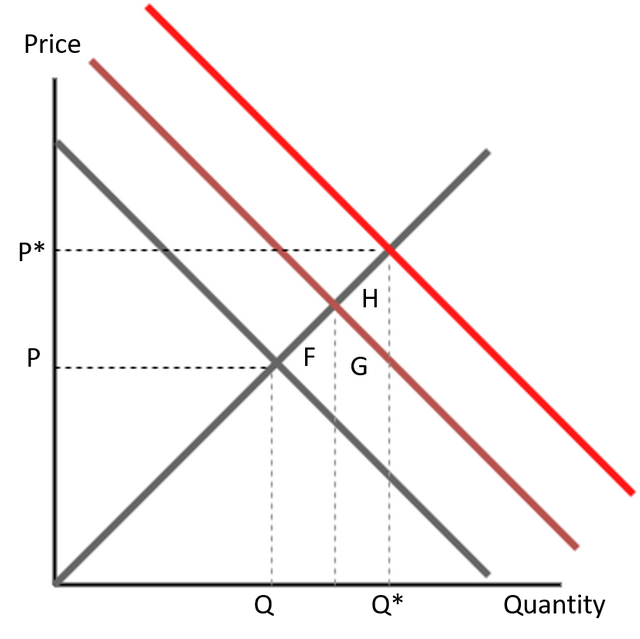[ECON 101 For Witness] Welfare Analysis on Discount Rate
Introduction
This series is inspired by a discussion on price feed discount rates with other witnesses. I will provide basic microeconomic concepts to understand how witness parameters have impacts on price, quantity, and welfare of each agents. In this first post, I will explain the effects of price feed discount on SBD buyers, sellers, and the network(that is, the whole STEEM stakeholders).
1.Basic Supply-demand Graph

This graph shows supply and demand curve of sellers and buyers, and equilibrium market point P and Q. Given market price P, the upper triangle represents buyer's surplus, that is the sum of difference between williness to pay and the market price. Similarily, the bottom means seller's surplus, the sum of difference between willingess to ask and the market price.
2.Discount Increases SBD Price

If SBD market price of P is below $1.00, witnesses can put discount on feed. This means that STEEM price is discounted or SBD has premium. Given x% feed discount, when SBD to STEEM conversion is filled, the network subsidizes x% more STEEM to a converter. It moves demand curve upwards, as presented in red line, and set a new market equilibrium wit higher price and quantity (P* and Q). With the feed discount, Steem system expects P will be close to $1.00.
3.Welfare Analysis of Discount

This part is very important and somewhat difficult. So let's start with simple things first. In the free market without any feed discount, given the market price P and quantity Q, the buyer's surplus is A+B and seller's surplus is C. Then what will happen witn new price P* and quantity Q*?
We said buyer's surplus is an upper triangle above the market price. So in this case, A+D. With same logic, we can easily find seller's surplus, B+C+E. In total, buyer and seller's surplus has changed from A+B+C to A+B+C+D+E. So we have Additional D+E now! But where does this money come from?
To answer this question, we need to think about who discounts. Witnesses? They just set the discount level and they don't pay anything from their pocket. It is the network(= stakeholders). The network compensate the difference between red demand line and black demand line, and in sum the amount is D+E+F. (FYI, similar graph is here).
The following table briefly summarizes welfare changes after introducing price feed discount.
| Before | After | Change | |
|---|---|---|---|
| Buyer | A+B | A+D | -B+D |
| Seller | C | B+C+E | +B+E |
| Stakeholder | 0 | -D-E-F | -D-E-F |
| Total | A+B+C | A+B+C-F | -F |
We found that while buyer and seller get better off, the stakeholders become worse off. Additioanlly, in total, we lose F, which is called the deadweight loss.
4.Greater Discount Leads Greater Loss

Suppose we introduce greater feed discount to facilitate SBD conversion. We can draw a new brighter red line that is higher than the old red line. We can easily find that the deadweight loss has increased from F to F+G+H. Also it is obvious that the stakeholders pay more, due to both a higher discount level and a greater quantity.
Conclusion
Since a higher feed discount increases burden on the stakeholders, witnesses should prudently determine the discount level. In the dynamic market it is hard to find the pinpoint accurately, but they always keep in mind that carelessly high discount will harm the stakeholders (but SBD market participants will love it). In the next post, I will explain how interest rates influence the market and each agent. If I can, I will cover the third element that can justify some deadweight loss, externalities.
Clayop I appreciate your efforts here. I just want to say that while your math and graphs may be right, I found this article near impossible to follow with all of the letters and math.
The goal is of using a premium or discount to the feed is simple: increase demand for SBD until SBD trades at $1.00 reliably and thereby proving the network is honoring its obligations to holders of SBD to receive a dollars worth of value.
From this perspective you cannot say that the stakeholders are harmed unless SBD starts consistently trading for more than $1.00.
The value of STEEM is complex and subject to liquidity. The value of SBD must factor in other risks etc.
I hope your future articles can articulate the economics in a way that is easier to follow. If I have trouble then I know that most of your readers will to.
First, I need to clarify that the stakeholders means STEEM stakeholders. Here, I started with a very simplified situation to explain basic microeconomic concepts. But following posts will expand the assumptions, and your point of view is probably related with the externalities (e.g. when the network breaks the social contract(SBD = $1), there will be negative influences that harms the value of network).
I will review this post to get across more easily. Thanks for your feedback.
That clearly simplified this matter for me. The whole thing seemed so much more complicated before I read this.
This post has been ranked within the top 80 most undervalued posts in the first half of Dec 03. We estimate that this post is undervalued by $6.95 as compared to a scenario in which every voter had an equal say.
See the full rankings and details in The Daily Tribune: Dec 03 - Part I. You can also read about some of our methodology, data analysis and technical details in our initial post.
If you are the author and would prefer not to receive these comments, simply reply "Stop" to this comment.
stop
We apologize for any inconvenience. You will no longer receive these comments on your posts.
Hi @clayop - I do agree with the idea that witnesses should discount as little as possible, while still maintaining an optimal USD peg and conversion rate. The "Smallest Effective Discount" as @bacchist called it.
Without having to rehash all the points we have discussed over the past week, I will just bring up one thing that I am curious to know your thoughts on.
If you assume that I am a SBD market participant that is going to try and maximize my own profits- Let's say I have $100 SBD that I am going to convert. I am going to try and get as much STEEM as I can, so I am going to try and wait for a low point.
If I wait to cash out until around the time of a 20% price drop, I am going to get around 20% more STEEM. In that scenario, wouldn't the network have been better off if it had incentivized me to convert before the drop with a 8% discount?
No. Think in dollar term. If you convert 100 SBD now with 8% discount, you will get STEEM with 108 USD value.
If you wait 20% STEEM price drop, or even 50%, then convert without any discount, you will get STEEM with 100 USD value. The STEEM amount will be greater in the latter, but in USD value the former is $8 greater, and the network pays $8.
I see your point of view. It is a completely valid way to look at it, and using that measurement the network is 'loosing'. With the 100 USD case though, there is also a higher dilution of STEEM. This has a cost to the network/ shareholders as well.
Your example is a relative thing based on an assumption. Suppose you won't convert unless the price drops 20%. If there is no discount and STEEM price goes up 20%, in contrast to your example, there will be no dilution. If the network provide 8% discount and you convert 100 SBD, there will be additional unnecessary dilution to the network.
So, it makes sense that the discount should be provided when STEEM price is in downtrend, but not in uptrend. If STEEM price seems more likely to increase, more discount just generates unnecessary dilution(sell pressure).
I agree 100% with this. If we knew with relative certainty that the price was going to go up, then a discount would be a horrible idea. Incentivizing people to convert at a 'discounted' rate when the network could have paid it back later for less (with no discount) is obviously a big loss for the network. I don't think that we can ever know this though, so we always have to assume that either direction has close to equal probability.
True, it can work out either way. People are motivated to wait until low points to convert though, so it is reasonable to assume that more conversions will happen during low points than higher ones.
This is actually the point for waiting to convert when the price drops...you get more STEEM. The hope is that the STEEM price will then rise at a later date, increasing your account value.
If you hold SBD from now until the price of STEEM doubles or triples - or more, you're not gaining anything because your SBD will still only buy $1 of STEEM. So, if STEEM is worth $0.50, you only get 2 per SBD. But if it's worth $0.05, you'll get 20. If you think the price will rise long-term, it makes more sense to convert the SBD when the STEEM price is low, regardless of any discount.
With 1 SBD, you can buy those 20 STEEMs at $0.05, then - if the price rises to $0.50, you just turned that 1 SBD into $10. No conversion discount will really give you that kind of profit.
The greater amount of STEEM means nothing if the price drops more. This seems little bit off-topic from my point of view.
This is exactly what I'm waiting to do. That time may come within the next couple of weeks. I can take my $700+ SBD and exchange it for a million STEEMs!
Hehe. Careful, it might just keep going up ;)
To the mooooon!
But first...to new lows. Then I make the dough. Then I get the khakis. Then I get the girls.
Thank you clayop still trying to understand all this still, also thanks upvoted you back.
Great explanation, the economics are well thought out here. Can't imagine how other platforms can exceed this amount of planning and discussion to benefit all stakeholders
This post has been linked to from another place on Steem.
Reports from the Witnesses 2016-12-04 by @timcliff
Advanced Steem Metrics Report for 3rd December 2016 by @ontofractal
TimCliff Witness Update 2016-12-03 by @timcliff
Learn more about and upvote to support linkback bot v0.5. Flag this comment if you don't want the bot to continue posting linkbacks for your posts.
Built by @ontofractal